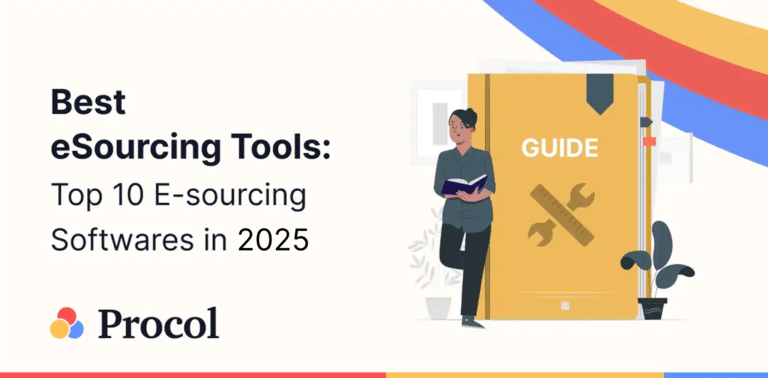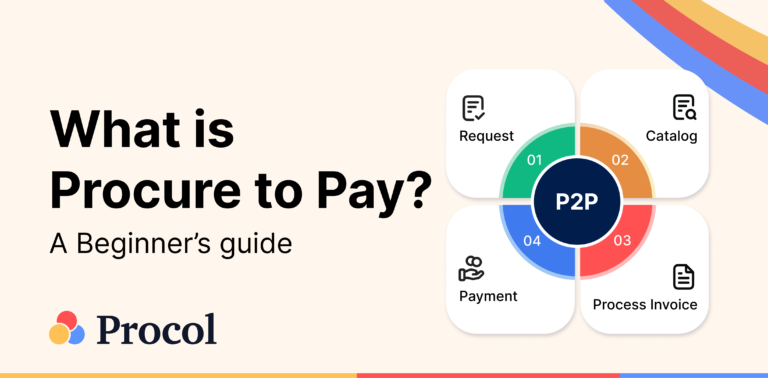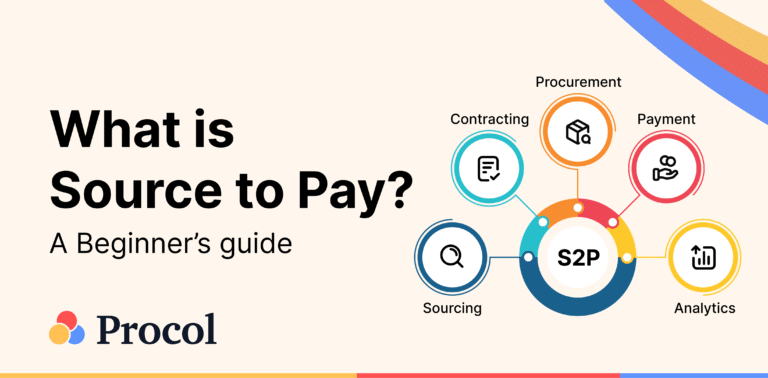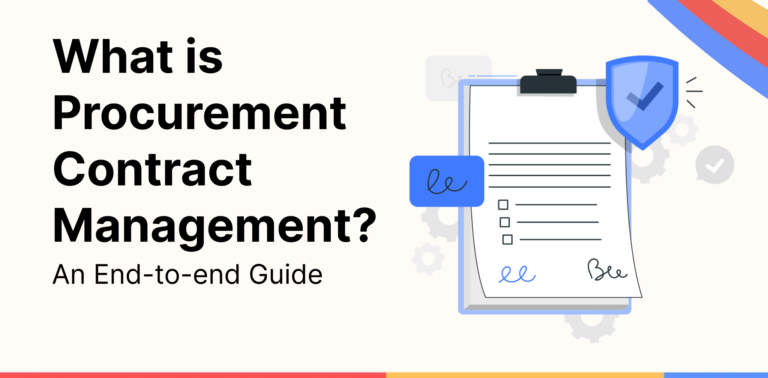Procol • April 15, 2025
Best eSourcing Tools: Top 10 eSourcing Software in 2025

Procurement, purchasing, and sourcing are phrases that are frequently used interchangeably but are actually quite different. Sourcing is a subset of procurement, focusing specifically on identifying, evaluating, and selecting suppliers. Procurement, on the other hand, encompasses a broader spectrum involving the entire process of acquiring goods or services, including negotiation, purchasing, and contract management. In essence, while sourcing is about finding the right suppliers, procurement is about managing the entire supply chain process.
eSourcing and eProcurement
eSourcing and eprocurement are integral components within supply chain management. While they share common goals of efficiency, cost savings, and enhanced transparency, they serve different functions.
What is eSourcing?
ESourcing refers to the use of electronic tools, platforms, or software to manage the sourcing process, which involves activities such as identifying potential suppliers, requesting and collecting bids, negotiating contracts, and ultimately selecting vendors. The aim of e sourcing is to streamline and digitize the entire procurement lifecycle, from the initial identification of needs to the final contract award.
What is eProcurement?
eProcurement focuses on the digitization of the entire procurement workflow, specifically the purchasing and transactional aspects. It involves electronic requisitioning, ordering, invoicing, and payment for goods and services. The goal of e procurement is to automate and optimize the purchasing process, reducing manual intervention and enhancing overall efficiency.
How Does eSourcing Work?
eSourcing, within procurement, is a method to streamline and optimize the process of sourcing goods and services from suppliers using digital technology. The e-sourcing process typically involves the following steps:
Identification of Requirements: The organization identifies its procurement needs, including specifications, quantities, delivery timelines, and any other important factors.
Supplier Discovery: Using e-sourcing platforms or existing supplier databases, the organization identifies potential suppliers that can meet the requirements.
Request for Information (RFI): The organization issues RFIs to shortlisted suppliers to gather general information about their capabilities, experience, and capacity to fulfil the requirements.
Request for Proposal (RFP): Qualified suppliers are invited to submit proposals detailing how they would meet the organization’s requirements, including pricing, delivery terms, quality standards, and any other relevant information.
Bid Evaluation and Negotiation: The organization evaluates the received proposals based on predefined criteria such as price, quality, delivery time, and supplier reliability.
Contract Award: After negotiations, the organization awards the contract to the selected supplier based on the evaluation results.
Order Fulfillment and Performance Monitoring: Once the contract is in place, the organization places orders with the selected supplier.
Supplier Relationship Management (SRM): Esourcing platforms contribute to building strong supplier relationships through ongoing communication and collaboration, and identifying opportunities for continuous improvement.
Types of Sourcing Processes
Here are different types of sourcing processes based on an organization’s unique needs and requirements:
1. Outsourcing: Delegating specific business processes or functions to external service providers.
2. Insourcing: Involves keeping business processes or functions in-house.
3. Near Sourcing: Sourcing goods or services, often from the same geographical region.
4. Low-Cost Country Sourcing: Procuring goods or services from countries with lower production and labour costs.
5. Global Sourcing: Sourcing goods or services from different parts of the world to leverage diverse markets and resources.
6. Single Sourcing: Concentrating the procurement of goods or services with a single supplier.
7. Multi-Sourcing: Distributing the sourcing of goods or services across multiple suppliers.
8. Joint Venture: Collaborative partnership between two or more organizations for a specific project or business venture.
9. Vertical Enterprise: Merging multiple stages of the supply chain within a single organization.
10. Captive Service Operations: Establishing a dedicated subsidiary or unit to perform specific business functions.
At the heart of procurement lies sourcing – the art of identifying and selecting suppliers to meet an organization’s needs. Sourcing involves activities such as supplier identification, evaluation, negotiation, and, ultimately, the selection of the most suitable suppliers to provide goods or services.
While traditional sourcing would have you flipping through directories, making endless phone calls, and drowning in paperwork, this is the era of esourcing platforms.
Organizations are ditching the old-school ways and turning to e sourcing tools to be the superhero in the procurement process.
What is eSourcing Software?
eSourcing software can be defined as the digital backbone of modern procurement, revolutionizing the way organizations identify, evaluate, and collaborate with suppliers. At its core, esourcing software leverages technology to automate and optimize various procurement activities.
Unlike traditional sourcing methods, which often involve manual processes, esourcing tools and software automate, centralize, and optimize various procurement activities. Esourcing platforms are designed to facilitate collaboration between buyers and suppliers, driving a more efficient and transparent procurement process.
The Benefits of Using eSourcing Software
From efficiency gains to cost savings, scalability to compliance assurance, esourcing tools represent a giant leap forward in the evolution of procurement practices and provide a strategic advantage.
Here are the benefits of incorporating esourcing tools into your procurement arsenal:
1. Efficiency and Time Savings
Imagine streamlining the supplier selection process and cutting it short from a couple of weeks to a couple of days. Esourcing platforms significantly reduce the time required for activities like RFPs (Request for Proposals) and RFQs (Request for Quotations) by automating document creation, distribution, and evaluation. This not only accelerates decision-making but also allows procurement professionals to focus on strategic tasks.
2. Enhanced Collaboration
Esourcing platforms provide a centralized space for buyers and suppliers to collaborate in real-time. This fosters better communication, reduces errors, and enables quick resolution of issues, creating a more collaborative and productive procurement ecosystem.
3. Data-Driven Decision Making
Data is the cornerstone of effective decision-making. E sourcing tools generate valuable insights by capturing and analyzing data throughout the procurement process. This enables informed decision-making, empowering organizations to identify cost-saving opportunities, evaluate supplier performance, and optimize their overall procurement strategy.
4. Cost Reduction
One of the primary objectives of any procurement strategy is cost reduction. E sourcing software facilitates cost savings through competitive bidding, supplier negotiations, and the identification of more cost-effective alternatives. Esourcing platforms enhance transparency and also contribute to cost control and risk mitigation.
5. Compliance and Risk Management
Ensuring compliance and managing risks in procurement is of paramount importance. E sourcing tools enable organizations to enforce compliance with internal policies and external regulations. Additionally, esourcing platforms provide tools to assess and mitigate risks associated with suppliers, contracts, and market dynamics.
6. Scalability and Flexibility
As businesses grow and markets evolve, scalability becomes a critical consideration. E sourcing tools offer scalability, allowing organizations to adapt to changing requirements and scale their procurement processes seamlessly. This flexibility ensures that the platform remains a valuable asset as the organization expands.
Top 10 eSourcing Tools in Procurement
1. Procol
Here’s why Procol, with its unmatched features and capabilities, is the best e sourcing software:
Mobile-First Flexibility:
In a world where agility is paramount, Procol empowers your team with a mobile-first approach. Sourcing decisions are no longer confined to the office – Procol ensures your procurement professionals have the flexibility they need to drive efficiency wherever they are.
Customizable Workflows and Templates:
Recognizing that every organization is unique, Procol gives you the flexibility of customizable workflows and templates. Tailor the e-sourcing experience to align precisely with your organization’s needs to ensure optimal results.
Advanced Procol Features:
- PR/Intake Management: Flip Purchase Requisitions (PR) to RFQ/Auction instantly, ensuring rapid and efficient e-sourcing event creation.
- Commercial Bidding: Experience the best-in-class, mobile-first RFQ/eAuction platform with Procol, ensuring optimal results in your commercial bidding endeavors.
- Technical Comparison: Utilize Procol’s weighted techno-commercial evaluation and QCBS for a comprehensive and detailed technical comparison.
- Sourcing Project Management: Run multi-round/multi-stage sourcing projects seamlessly with Procol, ensuring efficiency in your project management endeavors.
- Sourcing Analytics: Monitor category spend with custom, self-serve analytics, providing you with the insights needed for strategic decision-making.
2. Deepstream
Deepstream is known for its advanced AI-powered analytics, real-time market insights, and predictive sourcing recommendations. Its user-friendly interface and automation capabilities make it stand out. Deepstream is most suitable for organizations with a focus on data-driven decision-making and advanced analytics needs.
3. Sourcing Dojo
Sourcing Dojo is known for collaborative sourcing, offering a platform that enhances communication and teamwork. It provides a transparent and intuitive interface for streamlined procurement processes. It is ideal for organizations placing a high value on collaboration and ease of use.
4. Simfoni
Simfoni stands out for its comprehensive suite covering spend analytics, sourcing, and contract management. Its emphasis on cost savings through advanced analytics and automation makes it a great choice. It is well-suited for organizations seeking an all-encompassing solution for procurement processes.
5. SAP Ariba
As a market leader, SAP Ariba offers a robust and scalable solution. Integration with other SAP modules and a vast supplier network enhance its appeal. It caters to organizations of all sizes but is usually the most preferred choice for large enterprises looking for an enterprise-grade solution with extensive functionality.
6. Coupa
Coupa is recognized for its user-friendly interface and cloud-based, mobile-friendly platform. It excels in spend management and has a strong focus on optimizing the user experience. It is a good fit for organizations valuing ease of use and a modern, cloud-based approach.
7. Promena
Promena has great e-sourcing and e-auction capabilities. It offers a flexible and customizable platform, particularly beneficial for organizations with complex sourcing needs. It is ideal for organizations prioritizing e-sourcing and auction functionalities.
8. Ivalua Sourcing
IVALUA is known for its modular approach, offering flexibility and scalability. It provides a comprehensive suite for source-to-pay processes with an emphasis on customization. It is great for organizations seeking a customizable and scalable solution for their sourcing needs.
9. Zycus
Zycus stands out for its end-to-end procurement suite, covering strategic sourcing, procurement, and contract management. It is known for its robust analytics and AI-driven insights. It is a great choice for organizations looking for a comprehensive procurement suite with advanced analytics.
10. WorkDay Strategic Sourcing
WorkDay’s Strategic Sourcing module integrates seamlessly with its broader suite, providing a unified platform for procurement processes. Its intuitive design and reporting capabilities make it user-friendly. It is best suited for organizations already using or considering WorkDay for their overall HR and finance needs.
Types of eSourcing Tools
Here are the essential types of esourcing tools, what they do, and why you need them to transform your procurement landscape and elevate your sourcing game:
1. RFx (Request for Information/Proposal/Quotation):
- What: The cornerstone of e-sourcing, RFx tools automate the process of requesting and collecting information from suppliers.
- Why: Streamlines supplier selection, accelerates decision-making and ensures a standardized approach.
2. Reverse Auctions:
- What: Flips the traditional auction model, allowing suppliers to bid down prices competitively.
- Why: Drives cost savings through increased competition among suppliers.
3. Supplier Collaboration Portal:
- What: A virtual space for real-time collaboration between buyers and suppliers.
- Why: Enhances communication, reduces errors, and fosters a collaborative procurement ecosystem.
4. Advanced Analytics and Reporting:
- What: Utilizes data analytics to provide actionable insights throughout the sourcing lifecycle.
- Why: Enables data-driven decision-making, identifies cost-saving opportunities, and evaluates supplier performance.
5. Contract Management Integration:
- What: Seamlessly integrates with contract management systems to ensure a smooth transition from sourcing to contract execution.
- Why: Enhances visibility into contract terms, expirations, and compliance, reducing risks.
6. Supplier Risk Management:
- What: Evaluates and monitors supplier risk factors, such as financial stability and geopolitical considerations.
- Why: Mitigates risks associated with supplier relationships and market dynamics.
7. Mobile Accessibility:
- What: Enables users to access the e-sourcing platform on mobile devices.
- Why: Facilitates flexibility and responsiveness, allowing users to stay connected on the go.
Choosing the Right eSourcing Platform
Selecting the best esourcing tool is akin to choosing a reliable business partner – it should align with your organization’s goals, enhance efficiency, and adapt to your organization’s evolving needs. When evaluating esourcing tools, consider the following criteria:
User-Friendly Interface:
- Ensure the platform is intuitive and user-friendly, minimizing the learning curve for your procurement team.
Integration Capabilities:
- Look for platforms that seamlessly integrate with other procurement systems, such as ERP and contract management tools.
Scalability:
- Opt for a platform that can scale with your organization’s growth, accommodating increased data and user requirements.
Security Measures:
- Prioritize platforms with robust security features to safeguard sensitive procurement data.
Customer Support:
- Evaluate the level of customer support and training offered by the platform provider to ensure a smooth implementation process.
The journey from traditional sourcing to e-sourcing is a transformative one, marking a shift from manual processes to a future where data-driven decisions and streamlined collaboration define the procurement landscape. Using an esourcing suite of solutions is not just a technological upgrade; it’s a strategic imperative. By leveraging esourcing platforms, organizations can unlock unprecedented efficiency, collaboration, and cost savings.
Explore more from Procol
Discover expert tips, how-to guides, industry insights, and the latest procurement trends.

What is Procure-to-pay (P2P)? An Ultimate Guide
Procure to pay is the process from procurement of materials needed...

What is Source-to-pay in 2025? An Ultimate Guide
Source to pay is the process of sourcing vendors to procure...

End-to-End Guide to What is Procurement Contract Management?
Wondering what is procurement contract management, then this end-to-end guide explains...







